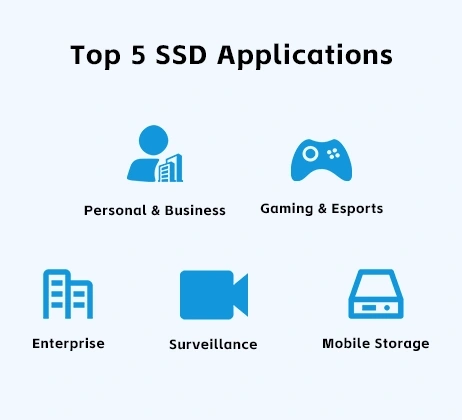The global storage component market is entering a new cycle of price increases. Driven by the rapid development of artificial intelligence (AI) and data center applications, major manufacturers have announced price hikes for SSD, HDD, and NAND flash products and have suspended some quotations. Increases are generally in the range of 10% to 30%, though the exact amount varies depending on the product category, capacity, and application. Rising logistics costs and longer delivery cycles are also significant factors pushing prices higher.
Against the backdrop of expanding AI and large-scale data processing applications, the supply-demand dynamics of the storage industry are undergoing significant changes. Recently, SanDisk notified customers of an approximately 10% price increase for its NAND flash products; Micron communicated to its channel partners that storage product prices will rise by 20% to 30% and has suspended all product quotations.
Western Digital (WD) has also notified its customers that it will adjust prices across its entire HDD product line in response to “unprecedented demand” for “every capacity” in its portfolio. The company simultaneously announced a shift towards more frequent use of ocean freight instead of air freight, which will extend shipping times by approximately six to ten weeks.
Meanwhile, delivery lead times for “nearline HDDs” (high-capacity storage not requiring extremely high-speed online access) have been pushed beyond 52 weeks, or about a year, creating significant pressure for cloud service providers and data center operators.
Major Company Dynamics
| الشركة | Announced or Expected Price Increase Measures / Dynamics | Price Increase / Affected Products | Other Related Actions or Warnings (e.g., Lead Times, Quote Suspension) |
|---|---|---|---|
| SanDisk | Announced price increase for NAND flash products across all channels | Approximately +10% | Industry quotes/contract negotiations impacted alongside Micron/WD etc. |
| Micron | Suspended quotations for NAND & DRAM; considering larger price increases | Supply chain sources indicate potential increases of up to 30%, especially for NAND products used in enterprise/data center applications. | Quote freeze; suspension of contract/price negotiations observed. |
| Western Digital (WD) | Notified customers of price increases for entire HDD product line; expanding price adjustment mechanisms for HDD & NAND flash | Increases cover all HDD capacities; NAND flash also under adjustment; specific percentages estimated in the 10-30% range or higher. | Significant extension of delivery lead times (logistics delays extending to months); quotation frequency and methods may change. |
Cause Analysis
Analysts point out that this round of price hikes is not accidental but the result of multiple converging factors. Firstly, AI inference and training workloads require processing massive amounts of data, driving a sharp rise in demand for high-speed, high-capacity storage. This not only increases the need for SSDs for primary storage/fast caching but also causes a surge in demand for “nearline” storage and cold storage, rapidly boosting demand for HDDs and high-capacity NAND.
Secondly, rising raw material costs, slow production capacity adjustments, and supply chains that haven’t fully recovered or expanded post-pandemic make it difficult for the supply side to immediately match demand growth. Some manufacturers, aiming to control output or improve gross margins, are choosing to suspend quotations or adjust production volumes to manage backlogs and costs. Micron’s quote suspension is a clear example.
Thirdly, transportation and logistics costs are also pushing overall costs higher. Shifting from air to ocean freight can save some transport expenses, but the resulting longer lead times mean increased inventory and delivery risks. Customers who don’t place orders in advance may face long waiting times or supply shortages.
Impact and Reaction
This price increase will have ripple effects across multiple levels. For large cloud service providers, AI companies, and data center operators, equipment procurement costs will rise significantly. If they haven’t locked in prices and delivery terms in advance, they may face budget pressures. Some users may lean towards signing long-term contracts or making advance payments to secure supply.
In the consumer market, retail prices for mid-to-high capacity SSDs are likely to rise gradually in the coming months. Consumers purchasing external storage, upgrading PC storage, or replacing laptop drives will feel the pressure of these price increases more readily.
Supply-demand imbalances may also trigger delivery delays and inventory shortages. Inventory strategies, financing costs, and cash flow for manufacturers and distributors will face significant tests. End-product manufacturers unable to secure needed storage components in time could experience product launch delays or extended production cycles.
The competitive landscape is also shifting. Companies with strong capital resources and capacity expansion capabilities are expected to adapt first and benefit, while smaller players or those with tighter profit margins may be marginalized under cost and delivery pressures. Technologically, higher-density NAND like QLC, PLC, and nearline SSD product lines may gain more attention as they potentially offer a better balance between cost and performance.
Future Outlook
If storage component capacity expansion and supply chain efficiency improvements can keep pace with demand growth, the price increase trend might ease in the medium term. However, in the short term, due to continued AI investment and the lengthy cycles of data center expansion, storage price pressures are not expected to disappear quickly.
Furthermore, policies, tariffs, energy, and raw material costs remain variables. If these cost factors experience new increases or disruptions, such as trade restrictions or logistics interruptions, they could exacerbate further price hikes for storage products.
الخاتمة
The storage industry is undergoing a systemic transformation driven by AI and big data. The rising prices for storage components not only reflect technological and market advancements but also expose the fact that the current supply system hasn’t fully adapted to the explosive growth in demand. Those who can gain an edge in capacity, supply chain management, technological innovation, and cost control are likely to secure a leading position in the future storage market.




